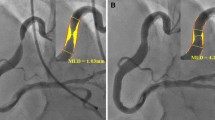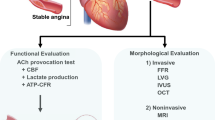Abstract
Increased reactive oxygen species (ROS) contributes to the development of endothelial dysfunction, which is involved in coronary artery spasm (CAS). Xanthine oxidoreductase (XOR) plays a pivotal role in producing both uric acid and ROS. However, the association between plasma XOR activity and CAS has not been elucidated. The aim of this study was to investigate whether plasma XOR activity is associated with CAS. We measured XOR activity in 104 patients suspected for CAS, who presented without significant coronary artery stenosis and underwent intracoronary acetylcholine provocation tests. CAS was provoked in 44 patients and they had significantly higher XOR activity as compared with those without CAS. The patients were divided into three groups based on the XOR activity. The prevalence rate of CAS was increased with increasing XOR activity. A multivariate logistic regression analysis showed that the 3rd tertile group exhibited a higher incidence of CAS as compared with the 1st tertile group [odds ratio (OR) 6.9, P = 0.001) and the 2nd tertile group (OR 3.2, P = 0.033) after adjustment for conventional CAS risk factors, respectively. The C index was significantly improved by the addition of XOR activity to the baseline model based on CAS risk factors. Furthermore, the 3rd tertile group had the highest incidence of severe spasm defined as total obstruction, flow-limiting stenosis, diffuse spasm, multivessel spasm, and/or lethal arrhythmia. This is a first report to elucidate the association of plasma XOR activity with CAS. Increased plasma XOR activity is significantly associated with CAS.






Similar content being viewed by others

References
Finegold JA, Asaria P, Francis DP (2013) Mortality from ischaemic heart disease by country, region, and age: statistics from World Health Organisation and United Nations. Int J Cardiol 168:934–945
Yasue H, Nakagawa H, Itoh T, Harada E, Mizuno Y (2008) Coronary artery spasm–clinical features, diagnosis, pathogenesis, and treatment. J Cardiol 51:2–17
Pristipino C, Beltrame JF, Finocchiaro ML, Hattori R, Fujita M, Mongiardo R, Cianflone D, Sanna T, Sasayama S, Maseri A (2000) Major racial differences in coronary constrictor response between japanese and caucasians with recent myocardial infarction. Circulation 101:1102–1108
Lanza GA, Careri G, Crea F (2011) Mechanisms of coronary artery spasm. Circulation 124:1774–1782
Hung MJ, Hu P, Hung MY (2014) Coronary artery spasm: review and update. Int J Med Sci 11:1161–1171
Munzel T, Camici GG, Maack C, Bonetti NR, Fuster V, Kovacic JC (2017) Impact of oxidative stress on the heart and vasculature: Part 2 of a 3-Part series. J Am Coll Cardiol 70:212–229
Khosla UM, Zharikov S, Finch JL, Nakagawa T, Roncal C, Mu W, Krotova K, Block ER, Prabhakar S, Johnson RJ (2005) Hyperuricemia induces endothelial dysfunction. Kidney Int 67:1739–1742
Battelli MG, Bolognesi A, Polito L (2014) Pathophysiology of circulating xanthine oxidoreductase: new emerging roles for a multi-tasking enzyme. Biochim Biophys Acta 1842:1502–1517
Otaki Y, Watanabe T, Kinoshita D, Yokoyama M, Takahashi T, Toshima T, Sugai T, Murase T, Nakamura T, Nishiyama S, Takahashi H, Arimoto T, Shishido T, Miyamoto T, Kubota I (2017) Association of plasma xanthine oxidoreductase activity with severity and clinical outcome in patients with chronic heart failure. Int J Cardiol 228:151–157
Nishino M, Mori N, Yoshimura T, Nakamura D, Lee Y, Taniike M, Makino N, Kato H, Egami Y, Shutta R, Tanouchi J, Yamada Y (2014) Higher serum uric acid and lipoprotein(a) are correlated with coronary spasm. Heart Vessels 29:186–190
Mancia G, Fagard R, Narkiewicz K, Redon J, Zanchetti A, Bohm M, Christiaens T, Cifkova R, De Backer G, Dominiczak A, Galderisi M, Grobbee DE, Jaarsma T, Kirchhof P, Kjeldsen SE, Laurent S, Manolis AJ, Nilsson PM, Ruilope LM, Schmieder RE, Sirnes PA, Sleight P, Viigimaa M, Waeber B, Zannad F (2014) 2013 ESH/ESC practice guidelines for the management of arterial hypertension. Blood Press 23:3–16
Murase T, Nampei M, Oka M, Miyachi A, Nakamura T (2016) A highly sensitive assay of human plasma xanthine oxidoreductase activity using stable isotope-labeled xanthine and LC/TQMS. J Chromatogr B Analyt Technol Biomed Life Sci 1039:51–58
Sugano Y, Anzai T, Yagi T, Noma S (2010) Impact of high-density lipoprotein cholesterol level in patients with variant angina pectoris. Int J Cardiol 140:175–181
Li YH, Lin GM, Lin CL, Wang JH, Chen YJ, Han CL (2013) Relation of serum uric acid and body mass index to mortality in high-risk patients with established coronary artery disease: a report from the ET-CHD registry, 1997-2006. J Cardiol 62:354–360
Li M, Hu X, Fan Y, Li K, Zhang X, Hou W, Tang Z (2016) Hyperuricemia and the risk for coronary heart disease morbidity and mortality a systematic review and dose-response meta-analysis. Sci Rep 6:19520
Puddu P, Puddu GM, Cravero E, Vizioli L, Muscari A (2012) Relationships among hyperuricemia, endothelial dysfunction and cardiovascular disease: molecular mechanisms and clinical implications. J Cardiol 59:235–242
Glantzounis GK, Tsimoyiannis EC, Kappas AM, Galaris DA (2005) Uric acid and oxidative stress. Curr Pharm Des 11:4145–4151
Cantu-Medellin N, Kelley EE (2013) Xanthine oxidoreductase-catalyzed reactive species generation: a process in critical need of reevaluation. Redox Biol 1:353–358
Hellsten-Westing Y (1993) Immunohistochemical localization of xanthine oxidase in human cardiac and skeletal muscle. Histochemistry 100:215–222
Chen C, Lü J-M, Yao Q (2016) Hyperuricemia-related diseases and xanthine oxidoreductase (XOR) inhibitors: an overview. Med Sci Monit 22:2501–2512
Forstermann U, Xia N, Li H (2017) Roles of vascular oxidative stress and nitric oxide in the pathogenesis of atherosclerosis. Circ Res 120:713–735
Lefroy DC, Crake T, Uren NG, Davies GJ, Maseri A (1993) Effect of inhibition of nitric oxide synthesis on epicardial coronary artery caliber and coronary blood flow in humans. Circulation 88:43–54
Spiekermann S (2003) Electron spin resonance characterization of vascular xanthine and NAD(P)H oxidase activity in patients with coronary artery disease: relation to endothelium-dependent vasodilation. Circulation 107:1383–1389
Radi R, Beckman JS, Bush KM, Freeman BA (1991) Peroxynitrite oxidation of sulfhydryls. The cytotoxic potential of superoxide and nitric oxide. J Biol Chem 266:4244–4250
George J, Carr E, Davies J, Belch JJ, Struthers A (2006) High-dose allopurinol improves endothelial function by profoundly reducing vascular oxidative stress and not by lowering uric acid. Circulation 114:2508–2516
Nakagawa H, Morikawa Y, Mizuno Y, Harada E, Ito T, Matsui K, Saito Y, Yasue H (2009) Coronary spasm preferentially occurs at branch points: an angiographic comparison with atherosclerotic plaque. Circ Cardiovasc Interv 2:97–104
Morita S, Mizuno Y, Harada E, Nakagawa H, Morikawa Y, Saito Y, Katoh D, Kashiwagi Y, Yoshimura M, Murohara T, Yasue H (2014) Differences and interactions between risk factors for coronary spasm and atherosclerosis–smoking, aging, inflammation, and blood pressure. Intern Med 53:2663–2670
Ishii M, Kaikita K, Sato K, Tanaka T, Sugamura K, Sakamoto K, Izumiya Y, Yamamoto E, Tsujita K, Yamamuro M, Kojima S, Soejima H, Hokimoto S, Matsui K, Ogawa H (2015) Acetylcholine-provoked coronary spasm at site of significant organic stenosis predicts poor prognosis in patients with coronary vasospastic angina. J Am Coll Cardiol 66:1105–1115
Yamagishi M, Miyatake K, Tamai J, Nakatani S, Koyama J, Nissen SE (1994) Intravascular ultrasound detection of atherosclerosis at the site of focal vasospasm in angiographically normal or minimally narrowed coronary segments. J Am Coll Cardiol 23:352–357
Battelli MG, Polito L, Bolognesi A (2014) Xanthine oxidoreductase in atherosclerosis pathogenesis: not only oxidative stress. Atherosclerosis 237:562–567
Tsushima Y, Nishizawa H, Tochino Y, Nakatsuji H, Sekimoto R, Nagao H, Shirakura T, Kato K, Imaizumi K, Takahashi H, Tamura M, Maeda N, Funahashi T, Shimomura I (2013) Uric acid secretion from adipose tissue and its increase in obesity. J Biol Chem 288:27138–27149
Patetsios P, Song M, Shutze WP, Pappas C, Rodino W, Ramirez JA, Panetta TF (2001) Identification of uric acid and xanthine oxidase in atherosclerotic plaque. Am J Cardiol 88(188–191):a186
Shimokawa H, Takeshita A (2005) Rho-kinase is an important therapeutic target in cardiovascular medicine. Arterioscler Thromb Vasc Biol 25:1767–1775
Crea F, Lanza GA (2011) New light on a forgotten disease: vasospastic angina. J Am Coll Cardiol 58:1238–1240
George J, Struthers AD (2009) Role of urate, xanthine oxidase and the effects of allopurinol in vascular oxidative stress. Vasc Health Risk Manag 5:265–272
Acknowledgements
This work was in part supported by the consigned research fund from Sanwa Kagaku Kenkyusho Co., Ltd and by Japan Society for Promotion of Science KAKENHI (Grant No. 17K15984, 18K08025, 18K08059, and 18K15838). We also would like to thank Editage (https://www.editage.jp) for the English language review.
Author information
Authors and Affiliations
Corresponding author
Ethics declarations
Conflict of interest
The authors declare that they have no conflict of interest.
Rights and permissions
About this article
Cite this article
Watanabe, K., Shishido, T., Otaki, Y. et al. Increased plasma xanthine oxidoreductase activity deteriorates coronary artery spasm. Heart Vessels 34, 1–8 (2019). https://doi.org/10.1007/s00380-018-1207-4
Received:
Accepted:
Published:
Issue Date:
DOI: https://doi.org/10.1007/s00380-018-1207-4



